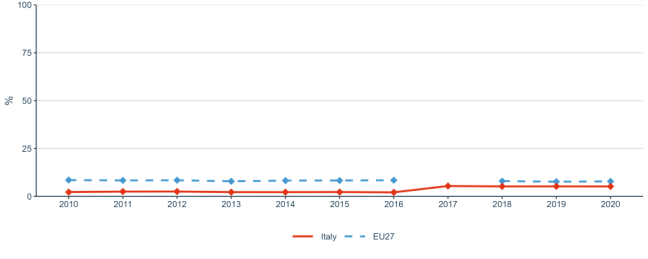ERA Country Report 2023
Italy
Edited by Gabriele Galassi (Ecorys)
as part of ‘Development of the ERA Scoreboard, the ERA Dashboard and the Regular Reports’ project for the European Commission, Directorate-General for Research and Innovation under Framework Contract N° 2018/RTD/A2/OP/PP-07001-2018 Lot 2 (EDAR)
Click here to download this country report![]()
- Table of contents
-
ERA Country Report 2023: Italy
1. National context
1.1. Overview of the ERA policy agenda implementation
1.2. Policy context
2. Assessment of the Implementation of the ERA Policy Agenda and ERA Priorities
2.1. ERA Priority 1: Deepening a truly functional internal market for knowledge
2.2. ERA Priority 2: Taking up together the challenges posed by the twin green and digital transition and increasing society’s participation in the ERA
2.3. ERA Priority 3: Amplifying access to research and innovation excellence across the Union
2.4. ERA Priority 4: Advancing concerted research and innovation investments and reforms
3. Country-specific drivers and barriers
4. Final remarks
5. Bibliography
6. Annexes
6.1. Annex 1: Graphs
ERA Country Report 2023: Italy
|
Key takeaways:
|
1. National context
1.1. Overview of the ERA policy agenda implementation
Italy has committed to 14 ERA Actions: 1 to 8 corresponds to the first ERA priority (Deepening a truly functioning internal market for knowledge), 10 to 14 under the second ERA priority (Taking up together the challenges posed by the twin green and digital transition and increasing society’s participation in the ERA) and action 19 under ERA priority 4 (Advancing concerted research and innovation investments and reforms). According to the European Innovation Scoreboard, the country is a Moderate Innovator with a performance of 90.3% slightly above the average of the rest of EU Moderate Innovators.
In a nutshell, the National Research Plan (NRP) (Piano Nazionale di Ricerca) for the period 2021-2027 will focus on the development of open science and innovation of the research market (ERA Actions 1-8), whereas the National Recovery and Resilience Plan (NRRP) (Piano Nazionale di Ripresa e Resilienza) will tap into the need to enshrine the innovation of the research system with other challenges faced by the country (green transition, healthcare modernisation and efficiency of the public administration), reflected in ERA Actions 10-14. Moreover, within the NRRP, an investment of EUR 1.8 billion is allocated to support and finance the realisation of the NRP, with a specific investment “Fund for the National Research Programme (PNR) and Research Projects of Significant National Interest (PRIN). Lastly, the National Plan for Research Infrastructure (NPRI) (Piano Nazionale delle Infrastrutture di Ricerca) reflects upon the different strategies and initiatives that the government will implement in the period 2021-2027 to empower and sustain the development of its research infrastructure, a horizontal initiative covering ERA Actions 5-8, with an NRRP Investment of EUR 1,6 billion.
The need to tailor the research system reform is also underlined by the country specific recommendations provided in the European Semester Report 2023, where the need to significantly support research and innovation projects promoting private investment and tailoring the economic recovery is a clear recommendation. Italy has transposed these recommendations within its National Recovery and Resilience Plan (NRRP).
1.2. Policy context
The Ministry of University and Research (MUR) sets out Italy’s political priorities on research and oversees the country’s university. The Ministry entrusts an important set of competencies to the National Research Council (NRC), a public research institution supervised and financed by the MUR. Among other institutions, the NRC promotes innovation and competitiveness of the national industrial system, while encouraging the internationalisation of the Italian research. In addition, the Council works as an advisory body on the seven areas it covers.
In relation to ERA Priority 1 the main policy instrument is the NRP. Italy is committed to re-structure and enable the transition of the research system into a fully open science and innovation market. The 2022 and 2023 European Semester Reports pointed out that the NRRP is well-placed to ensure that the country taps into the digitalisation of its economy and business sector. Additionally, measures such as the Annual Competition Law of 2022 were published to facilitate and speed-up the generation of new small- and medium-sized businesses. Furthermore, the NRRP enabled Italy to adopt a comprehensive reform of the R&D system in 2022 which aimed at streamlining the process for selection and awarding of research projects.
Italy is committed to the green and digital transition covered by ERA Priority 2. Also in this ERA Priority the NRRP is a key tool for generating progress. It is structured along three axes: digitalisation and innovation, green transition, and social inclusion. In fact, Mission 4, together with Mission 1 and 6 of the Plan, reflect the need for a more structured research system as a way to tap into the deficits of the public administration, modernise the national healthcare and university research system and enable national businesses to grow and expand in a sustainable way.
2. Assessment of the Implementation of the ERA Policy Agenda and ERA Priorities
Chapter 2 has two objectives: 1) It qualitatively assesses the state-of-play of the implementation of the ERA Actions that Italy has committed to. The qualitative information primarily stems from the OECD STIP survey 2023, supplemented by further desk research; 2) It quantitatively assesses the country’s progress towards achieving the ERA priorities as set out on the Pact for Research and Innovation in Europe. The presented quantitative information is mainly based on the ERA Scoreboard and ERA Dashboard indicators, and covers longer-term trends since 2010. Additionally, general indicators for the overall R&I system are outlined in Table 1. More detailed information on the data and graphs can be found in Annex 1. This report will serve as a baseline for reporting in the future.
|
Indicator |
Most recent EU average |
Most Recent Metric |
|
Gross Domestic Expenditure on R&D (GERD) as a percentage of GDP |
2.26 (2021) |
1.49 (2021) |
|
Government Budget Allocations for R&D (GBARD) as a share of GDP |
0.76 (2021) |
0.66 (2021) |
|
Researchers (in full-time equivalent) per million inhabitants |
4,483.4 (2021) |
2,915.8 (2021) |
|
Business Enterprise expenditure on R&D (BERD) as a percentage of GDP |
1.49 (2021) |
0.9 (2021) |
Source: compiled by research team based on the ERA Scoreboard and ERA Dashboard indicators
2.1. ERA Priority 1: Deepening a truly functional internal market for knowledge
2.1.1. State of play in the implementation of the ERA Actions
In relation to the ERA Action 1: Enable the open sharing of knowledge and the re-use of research outputs, including through the development of the European Open Science Cloud (EOSC), the Ministry of Universities and Research has launched the National Plan for Open Science (NPOS) (Piano Nazionale per la Scienza Aperta). The plan includes several measures to reinforce the participation of a broader set of research communities at the European and international levels in various open science hubs and organisations.
Currently, several R&I institutions, universities, data, and electronic infrastructures have joined the EOSC Association or have participated in several EU R&I Framework Programme projects related to EOSC. However, the support from the national research community in a centralised manner on how to successfully ensure good quality of open data is still missing according to both the NRRP and the NPOS. There is an online portal where science organisations are able to share their information, results and events. ^ However, the potential of open science is still not fully employed in Italy and several organisations have affirmed how relevant it would be to see more of a nationally coordinated effort in the organisation of an open science community.
Recently, the political debate on data legislation has grown in Italy. In fact, the National Data Protection Authority expressed prudence on the launch of several Artificial Intelligence tools temporarily restricting their use for several privacy-related issues. ^ However, the Italian landscape for the implementation of ERA Action 2: Propose an EU copyright and data legislative framework for research favourably sets out a data-protection environment that is closing the gap with EU standards. The legislative decree 101 of August 2018 ^ in fact allows derogations for holding data for several scientific and research purposes. The provision was heavily discussed in both Parliament and Senate and finally a series of amendments allowed for a specific list of fields where the re-use of data is allowed and where it is not.
Italy is progressing towards ERA Action 3: Reform the assessment System for research, researchers and institutions, with instruments such as the National Agency for the Evaluation of Research and University (NAERU). ^ NAERU was awarded amongst the most reliable agencies ^ for research and university rating and is a member of the European Association for Quality Assurance in Higher Education (ENQA). The ENQA report, considers NAERU´s approach to dissemination and the management method it encourages, as good and commendable practices in the evaluation of academic and research performances.
The implementation of ERA Action 4: Promote attractive research careers, talent circulation and mobility represent an important opportunity for the Italian R&I system. Italy experiences huge scarcity of qualified human resources, as evidenced by the low rate of people with tertiary education and the decrease in the PhD students during the last years. ^ All this reflects the urgency for Italy to quickly implement the respective ERA Action also channelling resources from the NRRP.
In 2022, the Ministry of Universities and Research aimed to encourage talent circulation and mobility through allowing temporary mobility between universities, public research institutions and companies to carry out specific research projects. Moreover, it is important to mention that NRRP resources play an important role in the implementation of policies aimed at attracting international researchers. ^
The landscape for the implementation of ERA Action 5: Promote gender equality and foster inclusiveness has been improving during the last years. In fact, several measures are included both in the NRRP and in the NRP to tap into the inclusion and involvement of women in academic positions, not only related to STEM subjects. More specifically, the adoption of horizontal indicators monitoring the gender balance and inclusion of women in the new position created are promising precursors for the future ^.
Italy has increased its efforts towards ERA Action 6: Protect academic freedom in Europe. Concerning academic freedom and institutional autonomy, the legal protection of academic freedom in the country is strong, and the de facto situation is comparatively positive. ^ The Italian system has made efforts to address issues of corruption and nepotism in academic circles. Moreover, the universities reform of 2010 ^ contributed to a regression of nepotism and corruption phenomena in the academic context by prohibiting the contracting of family members and close relatives of those already employed inside universities. Finally, Italy actively participated in the creation of the G7-Virtual Academy, an important guide for the G7 scientific communities to share best practices and implement useful strategies to address threats to the security and integrity of research.
The Italian context related to ERA Action 7: Upgrade EU guidance for a better knowledge valorisation presents itself as more than promising for the implementation of the action. Several initiatives undertaken in the period have enhanced the linkages between the national research system and the business sector. As an example, "PhD iTalents” project, a public-private initiative promoted by MUR, is a three-year pilot project that aimed to bring universities and enterprises closer by fostering the matching process between companies’ demand and the supply of PhDs. This rising level of cooperation between research and enterprise sectors is expected to continue in the coming years. In fact, within the NRP ^ and the NRRP the Minister of Universities and Research allocated funds for approximately 13,000 grants for innovative PhD careers responding to the enterprise sector requests” ^ and the “creation and enhancement of innovative ecosystems at the local level”, initiatives set to further tailor the mismatch between knowledge required by the business sector and the competences that researchers are equipped with. Finally, it is worth mentioning that the NRRP (investments 1.3, 1.4, and 1.5) envisaged a EUR 4,5 billion investment to strengthening research and dissemination of innovative models for applied research conducted in synergy between universities and businesses.
The focus towards a more resilient, sustainable and accessible research infrastructure system enshrined in ERA Action 8: Strengthen sustainability, accessibility and resilience of research infrastructures in the ERA is reflected in the importance that Italy dedicates to Research Infrastructures at the national and European level. The country is in fact the member state with the largest number of memberships in European Research Infrastructure Consortium (ERIC) (23) ^ . Since 2010, Italy has invested more than EUR 1 billion via the “Ordinary Fund for Public Research Bodies”. The objective of guaranteeing access and sustainability of the Italian research infrastructure is enshrined in the NPRI aiming at providing favourable and sustainable conditions for researchers to entry the research infrastructure system. Overall, Italy invests around EUR 1.6 billion within the NRRP to Research Infrastructures, of which around EUR 250 million are allocated to technology infrastructures.
2.1.2. Progress towards achieving ERA Priorities
Concerning Sub-priority 1.1: Open science, the data in Figure 5 in Annex 1 shows how Italy is performing aligned to EU standards in terms of open access available publications both in 2018 and 2019. Italy participates to the EOSC Tripartite Governance, is fully involved in the EOSC Steering Board and participate in the EOSC Association, which has 20 members and one mandate organisation that are involved in 13 EOSC-related projects.
On Sub-priority 1.2: Research Infrastructure, the share of national public R&D expenditure allocated to European research infrastructures of 2022 in Italy was 2.18%, i.e. considerably higher than the European average of 1.82%. ^ In addition, the number of European research infrastructures in which a Member State or an Associated Country participated in 2021 is considerably higher in Italy, with a value of 30, compared to the European average of 15.46 (Figure 6 in Annex 1). Moreover, the current Government has deliberated to allocate additional resources to the “Ordinary Fund for Public Research Bodies” in 2022, 2023 and 2024, with a further increase reaching EUR 100 million from 2025 onwards.
A promising pathway is also shown for Sub-priority 1.3: Gender equality, equal opportunities for al land inclusiveness. In fact, as shown in Figures 8 and 9 in Annex 1, the country has an above-EU-27 average percentage of women undertaking a research career related to STEM disciplines (2010 – 2020), complemented with numbers above EU-27 average also for women participating in scientific publications (including mixed authorship) from 2000 to 2020 and in the proportion of female authors of the top 10% most cited publications (Figure 10 in Annex 1). However, these numbers are balanced by a lower number of women in high positions in education institutions and (as shown in Figure 7 in Annex 1) less than 50% of women in the Digital Index in 2022 (lower than the 53% EU-27 average, Figure 11 in Annex 1).
On the other hand, Sub-priority 1.4: Careers and mobility of researchers and research assessment and reward system has seen a different growth rate than the previous. In fact, the share of foreign doctorate students as a percentage of all doctorate students (Figure 12 in Annex 1) was increasing from 2015 to 2018 but encountered a halt. This further increased the gap with the EU-27 average between 2018 and 2020. The number of new graduates per 1,000 inhabitants aged 25-34 (2015-2021) is recently (2019) increasing again following the EU-27 average, but still there is a minor gap to be filled (Figure 13 in Annex 1). The level of job-to-job mobility of Human Resources in science and technology (Figure 14 in Annex 1) has taken a different pace than the EU-27 average, and the gap has increased since 2017.
With respect to Sub-priority 1.5: Knowledge valorisation, Italy exhibits a growing share of public-private co-publications 2011-2021 (Figure 15 in Annex 1) performing above EU-27 average level for the period 2013-2021, with a peak of nearly 200 publications in 2021. Moreover, the country’s number of innovating firms collaborating with higher education institutions or public/private research institutions (Figure 19 in Annex 1) is on a positive drive within recent years, with the country finally coming to reach the EU-27 average in 2020 after a steady growth since 2016. The promising pattern is also reflected in the number of PCT patent applications divided by GDP 2010 -2015 (Figure 16, in Annex 1), where Italy’s performance aligned to the EU-27 average by nearly reaching 25% in 2015.
However, there is still a long way to go for the enhancement of the participation of the business sector in research, showcased by both Figure 17 and 18 in Annex 1, where Italy lags behind the EU-27 average both in terms of percentage of business enterprise researchers over the national researchers and business enterprise researchers in full-time equivalent per thousand employments. Specifically, the country tends to further deviate negatively from the EU-27 average instead of closing the gap.
Despite the main concerns on academic corruption and nepotism, the road towards implementing Sub-priority 1.6: Scientific leadership seems a bigger swift than expected. In fact, Italy scores very high (higher than EU-27 average) on the Academic Freedom Index (Figure 21 in Annex 1). Moreover, on the number of scientific publications among the top – 10% most cited publications worldwide as a percentage of all publications (Figure 20 in Annex 1), Italy performed on the same level as the EU-27 average until 2019 when a higher percentage was registered and a small gap with the EU was created.
On Sub-priority 1.7: Global engagement, Italy is performing significantly higher than the EU-27 average in the number of international co-publications with non-EU partners per 1,000 researchers in the public sector (Figure 22 in Annex 1), with over 1100 publications reached in 2020. Moreover, despite a lower data availability and a significant descending trend (also for the EU-27 average), the country saw higher values in international co-patenting in EPO applications at national and EU level (Figure 23 in Annex 1).
2.2. ERA Priority 2: Taking up together the challenges posed by the twin green and digital transition and increasing society’s participation in the ERA
2.2.1. State of play in the implementation of the ERA Actions
Regarding the context for the implementation of ERA Action 10: Make EU R&I missions and partnerships key contributors to the ERA, the National Plan for Research enshrines a strong collaboration with the projects and opportunities from the EU level. In particular, the plan has been timely aligned with the deadlines of programs such as Horizon Europe. The Plan will not only channel the national resources but also aims at being the structure of absorption of Horizon Europe funding for R&I projects. Moreover, the National Energy and Climate Plan (NECP) sets out strategies and measures to enable a sustainable and competitive transition of the energy system, whereby research and innovation play a vital role. Additionally, Italy takes part in all the European Partnerships. The Ministry of Universities and Research coordinates the Italian participation, providing, together with other Ministries, in cash and in-kind contributions and has formally committed for EUR 0.9 billion for 7 years.
On ERA Action 11: An ERA for green energy transformation, the abovementioned strategies also enable the further implementation of the action, but a further level of detail is necessary to uncover the state of play of the Italian research agenda and its role in the green energy transition. In fact, stemming from Mission 2 Component 2.1 of the National Recovery and Resilience Plan, several calls for research projects on hydrogen-based energy production are financed through the Ministry for Environment and Energy Security (Ministero per l’Ambiente e la Sicurezza Energetica). ^ Furthermore, the International Energy Agency (IEA) has also partnered with the Ministry and the United Nations Environment Programme (UNEP) for a call for pilot projects analysing how digitalisation impacts the realisation of a resilient energy system.
Following the state of play to enable the action above, the Italian landscape for the implementation of ERA Action 12: Accelerate the green/digital transition of Europe´s key industrial ecosystems is ensured by the measures enshrined in the NRRP. This is supported by the pilot projects from the Ministry of Environment and Energy Security on green hydrogen production, and from the Ministry of Public Administration on digitalisation of the public administration and productive sector. Moreover, the Ministry of Enterprise and Made in Italy launched the Italian Strategy for Hydrogen, aiming at creating a network of competencies, and to increase all the allocations for the research on hydrogen. The country’s hydrogen strategy puts forward the government’s intention of becoming one of the first hydrogen hubs in the Union. ^
Concerning ERA Action 13: Empower Higher Education Institutions to develop in line with the ERA, and in synergy with the European Education Area, Italy invests in strengthening its universities and research institutions. The strengthening of Italy's research infrastructure is due to the use of the resources made available by the NRRP. In addition, Italy is committed to support the membership of its universities in the European Universities Initiative. Concerning the attraction of international researchers, MUR has supported young international researchers, winners of ERC, MSCA and researchers who have obtained the Seal of Excellence, through investing in their education and projects.
With respect to ERA Action 14: Bring Science closer to Citizens, Italy has developed a series of plans and initiatives to support the involvement of citizens in science activities. For instance, within the National Research Programme, several missions enshrine the principles of citizen science and engagement as one of the key methods to realise research activities. Furthermore, several events and activities are tackling citizens’ participation and engagement in the dissemination of research content such as the European Researchers Nights (Notte dei Ricercatori Europei) and the Week of Scientific and Technological Culture (Settimana della Cultura Scientifica e Tecnologica).
2.2.2. Progress towards achieving ERA Priorities
On the implementation of Sub-priority 2.1: Challenge-based ERA actions, Italy exhibited an heterogenous performance in the Government Budget Allocations for R&D (GBARD) by NABS in energy; environment; transport, and telecommunications and other infrastructure (Figure 24 in Annex 1). In fact, the budget allocated for R&D activities in the energy sector has been significantly higher than the EU-27 average between 2010 and 2021. Furthermore, the allocation for the transport sector was more significant in the country than the EU-27 average.
In relation to the national public and private investments as suggested in the SET Plan progress report 2021 (Figure 27 in Annex 1), Italy exhibited a constant higher value than the EU-27 average until 2020, when the Italian value shows a big decrease. Figure 24 in Annex 1 on GBARD on the environmental sector showcased significantly higher allocation in Italy compared to the EU-27 average. In fact, Italy has exhibited higher values than the EU-27 average for the whole 2010-2019 period with respect to OECD patents on environmental technologies.
Furthermore, Italy has remained around the same values in terms of the environmentally related government R&D budget as percentage of total government R&D, as demonstrated in Figure 26 in Annex 1. Since 2016, the Italian values have been above the EU-27. Finally, Italy exhibits higher values with regards to the role that GBARD allocation plays in R&I investments to Europewide, transnational, bilateral or multilateral public R&D programmes per FTE researcher in the public sector (Figure 25 in Annex 1) compared to the EU-27 average, confirming the role that international mechanisms, programmes, and cooperation strategies play in the Italian research infrastructure.
The progress on Sub-priority 2.2: Synergies with education and the European Skills Agenda is quite promising for Italy. In fact, in 2019, the country presented a higher share of researchers receiving transferable skills training (Figure 29 in Annex 1) than the EU-27 average, showcasing the fundamental role that trainings and capacity building play in Italy’s research agenda.
Regarding Sub-priority 2.3: Synergies with sectorial policies and industrial policy, in order to boost innovation ecosystems, the direct and indirect government support through R&D tax incentives as a percentage of GDP saw a steep decrease and deviation from the EU-27 average in 2019 after four years of aligned performance. In fact, through the NRRP investment, Italy aims to boost the dialogue between the private and business sector and the research infrastructure, as well as to reinvert immediately the tendency exhibited in Figure 30 in Annex 1.
The country performs in alignment with the EU-27 average on Sub-priority 2.4: An active citizen and societal engagement in R&I in all its dimensions. In fact, the trust in science in 2021 (Figure 31 in Annex 1) showed a similar percentage both in Italy and the EU, whereas the number of publications on “social innovation” or “social entrepreneurship” per million population (Figure 32 in Annex 1) has constantly been above the EU-27 average (despite a descending curb within 2018 and 2021, still following the EU level).
2.3. ERA Priority 3: Amplifying access to research and innovation excellence across the Union
2.3.1. State of play in the implementation of the ERA Actions
Despite Italy not having committed to any of the actions related to ERA Priority 3, the Cohesion Policy Partnership between Italy and the Commission encourages the country´s efforts towards national cohesion. ^ In order to promote economic, social, and research collaboration to improve the R&I system, Italy receives from the partnership EUR 42.7 billion.
2.3.2. Progress towards achieving ERA Priorities
Despite a non-official commitment to any of the actions enshrined in this priority, in Sub-priority 3.1: More investments and reforms in countries and regions with lower R&I performance, Italy is proceeding in line with the EU-27 average in terms of increases (in percentage points) of total R&D expenditure expressed as a percentage of GDP from 2001 to 2021 (Figure 33 in Annex 1).
2.4. ERA Priority 4: Advancing concerted research and innovation investments and reforms
2.4.1. State of play in the implementation of the ERA Actions
The current context in which the country moves with regards to ERA Action 19: Establish an ERA monitoring system is particularly favourable for the implementation of the action. In fact, within the National Research Plan, several national indicators are set to monitor the progress on various prerogatives undertaken within the document (i.e. the number of citizens engaged in research activities, the number of Horizon Europe projects realised by national research institutions, etc.). To complement, a highly detailed indicators’ system was set up to monitor the progress towards reaching the objectives contained in the NRRP. A key point on the above regards the open access towards such data. In fact, through the monitoring website of the plan ^ it is possible to explore the progress made towards the objectives.
2.4.2. Progress towards achieving ERA Priorities
Recently, the country has seen an increase in the share of public R&D expenditures financed by the private sector (Figure 34 in Annex 1) from 2017 onwards. However, the country still needs to catch up with the EU-27 average. Hence, the progress made towards Sub-priority 4.1: Coordination of R&I investments still needs to be accelerated and tackled by national initiatives. With the National Research Plan, the country aims to empower the National Research Council to better monitor the involvement of private investors in the research framework, by creating networks of collaboration and high-level information sessions and events.
3. Country-specific drivers and barriers
A more general barrier for research and innovation in Italy has been the rather bureaucratic architecture, which consistently hindered investments and innovation to effectively rise and shine in Italy. ^ This issue will be further addressed within the coming years, with expected reforms and initiatives aiming to modernise and digitalise the public administration structure, being the first mission of the NRRP.
The main obstacles that the full upscale of the Italian research infrastructure faces lies on those underlined in the 2022 and 2023European Semester Reports, alongside the Country Specific Recommendations stemming from both documents. Italy needs to accelerate the digital transition in different sectors, especially in relation to public education and administration, and strengthen the pathway for the roll-out of research projects not only using public funding but also from the private sector.
Another barrier for the research and innovation sector is the demographic situation of the country. Italy in fact has the highest old age dependency ratio in Europe (57%), ^ a value that is expected to increase in the coming years. Hence, the attractiveness of the Italian research system is number one priority for the government to invert this tendency and reinforce its qualified human capital.
In order to strengthen the R&I environment in Italy, the NRRP address the current challenges emphasised in the 2022 European Semester Report. It is related to all ERA Actions, as its objectives are aligned with the ERA Policy Agenda. The plan aims to enhance the opportunity that the green and digital transitions offer, to make the R&I system more resilient, efficient and competitive.
4. Final remarks
Italy prioritises interventions in several areas included in the ERA Policy Agenda. With the intervention from the NRRPs, the Ministry of Universities and Research aims to expand the research community, ease the administrative burden hindering research processes, internationalise the country’s research infrastructure and portfolio and invest in creating attractive opportunities for Italian researchers.
These priorities reflect the country’s commitments to several actions under ERA priority 1: Deepening a truly functional internal market for knowledge. Among the major initiatives the country is putting in place are: the Special Integrative Funding for Research (a dedicated additional line of funding for the special interventions set out in the National Research Plan), the new reform of Doctoral Programs and the expected reform of the Research Infrastructure (aiming to boost mobility of researchers and simplify the absorption and capture of different lines of funding).
Furthermore, the country’s commitment to the Paris Agreement, the Agenda 2030 and the Green Deal boosted Italy’s targets for the green and digital transition as contained in the NRRP. The country is planning to become an important research hub for Hydrogen with the Italian Strategy for Hydrogen Research and several calls for pilot projects on research on the topic. This all feeds into the country’s road towards implementing several actions enshrined in ERA priority 2: Taking up together the challenges posed by the twin green and digital transition and increasing society’s participation in the ERA.
All in all, this report shows that the resources and opportunities coming from the National Recovery and Resilience Plan massively underpin the pathway Italy is dedicated to follow to counter some of the criticalities. However, based on the analysed indicators, the country stands aligned to the EU-27 average on various indicators and is overperforming in different areas and sectors.
5. Bibliography
“ANVUR – Agenzia Nazionale di Valutazione del Sistema Universitario e della Ricerca”, ANVUR website, available at: https://www.anvur.it/.
“Bernini: Le sei priorità del Ministero dell’Università e della Ricerca per il 2023”, website of the University and Research Ministery, available at: https://www.mur.gov.it/it/news/martedi-07022023/bernini-le-sei-priorita-del-ministero-delluniversita-e-della-ricerca-il-2023.
Law Decree n. 101, Decreto Legislativo n. 101, Government Gazette 205. 10/12/2018
Law Decree n. 240, Decreto legislativo n. 240, Government Gazette 10. 30/12/2010
“Enti di ricerca pubblici | Ministero dell’Università e della Ricerca”, website of the University and Research Ministery, available at: https://www.mur.gov.it/it/aree-tematiche/ricerca/il-sistema-della-ricerca/enti-di-ricerca-pubblici.
European Parliament. Directorate General for Internal Policies of the Union. (2023a). State of play of academic freedom in the EU Member States: Overview of de facto trends and developments. Publications Office. https://data.europa.eu/doi/10.2861/466486
Galanti, M. T. (2011) Is Italian Bureaucracy Exceptional? Comparing the Quality of Southern European Public Administrations, available at https://www.gla.ac.uk/media/Media_210759_smxx.pdf.
Gagliardi, D., Rondinone, B. M., Mirabile, M., Buresti, G., Ellwood, P., Hery, M., ... & Iavicoli, S. (2017). The perspective of European researchers of national occupational safety and health institutes for contributing to a European research agenda: a modified Delphi study. BMJ open, 7(6), e015336.
Grilli J, Allesina S. Last name analysis of mobility, gender imbalance, and nepotism across academic systems. Proc Natl Acad Sci U S A. 2017 07 18; 114(29):7600-7605, available at: https://www.pnas.org/doi/10.1073/pnas.1703513114.
“Home • ENQA”, ENQA website, available at: https://www.enqa.eu/.
“Istituti di ricerca”, National Research Council website, available at: https://www.cnr.it/it/istituti.
“Italy”, Centre for Intellectual Property and Information Law website, available at: https://www.cipil.law.cam.ac.uk/projectseuropean-data-protection-laws-and-freedom-expression/italy
“Le riforme del PNRR”, Italian National Recovery and Resilience Plan website, available at: https://www.italiadomani.gov.it:443/content/sogei-ng/it/it/Interventi/riforme.html
Maassen P., Martinsen D., Elken M., Jungblut J., Lackner E. State of play of academic freedom in the EU Member States (2023). Panel fro the Future of Science and Technology (STOA). Available at: https://www.europarl.europa.eu/RegData/etudes/STUD/2023/740231/EPRS_STU(2023)740231_EN.pdf
OECD. (2019). Supporting Entrepreneurship and Innovation in Higher Education in Italy. Organisation for Economic Co-operation and Development. Available at: https://www.oecd-ilibrary.org/education/supporting-entrepreneurship-and-innovation-in-higher-education-in-italy_43e88f48-en.
“PNRR. MiTE, pubblicati i bandi per 50 milioni di fondi per l’idrogeno” | National Ministry for Environment and Energy Security website, available at: https://www.mase.gov.it/comunicati/pnrr-mite-pubblicati-i-bandi-50-milioni-di-fondi-l-idrogeno
“Regolamenti”, National Research Council website, available at: https://www.cnr.it/it/regolamenti
“Valutazione di università e ricerca in Europa: L’Italia fa scuola”, Università website, available at: https://www.universita.it/valutazione-universita-ricerca-europa/.
Vinther-Jorgensen T., Beccari L., Del Mar Campis Eritja M., Gaiunas I. ENQA AGENCY REVIEW: Italian National Agency for the Evaluation of Universities and Research Institutes (ANVUR). (2019). ENQA AGENCY REVIEW. Available at: https://www.enqa.eu/wp-content/uploads/ANVUR-external-review-report.pdf
6. Annexes
6.1. Annex 1: Graphs
The 2023 ERA Scoreboard and ERA Dashboard indicators used in the country report are presented in this annex. Detailed information on the data sources, description of the indicators, time period for which the data is available, and the necessary calculations can be found in the ERA Scoreboard and ERA Dashboard Methodology Report. In addition, the research aimed to use the latest data available for each indicator, the most recent data for some of them dates from several years ago.
General Indicators
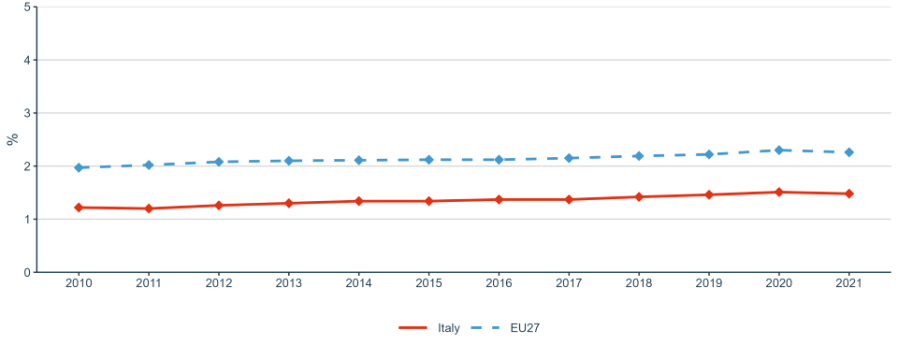

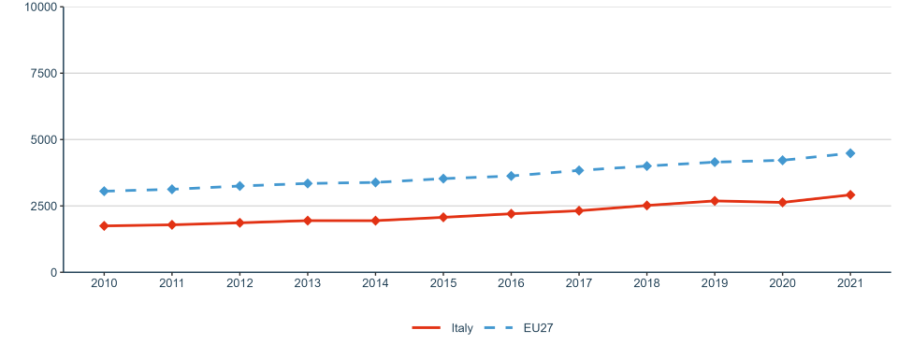

Priority 1: Deepening a truly functioning internal market for knowledge
Sub-priority 1.1: Open Science
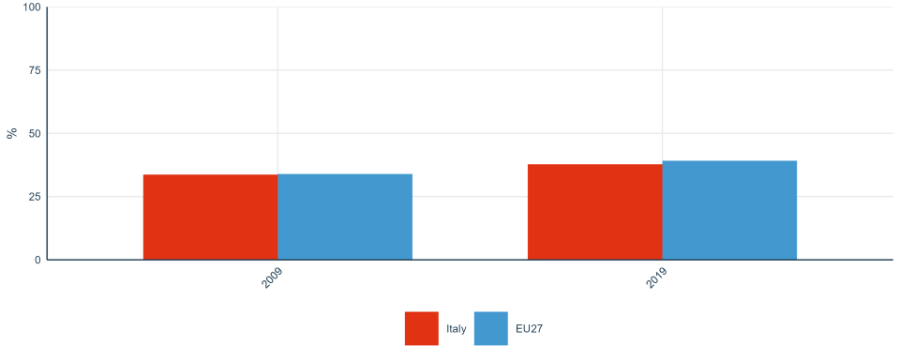
Sub-priority 1.2: Research infrastructures

Sub-priority 1.3: Gender equality, equal opportunities for all and inclusiveness
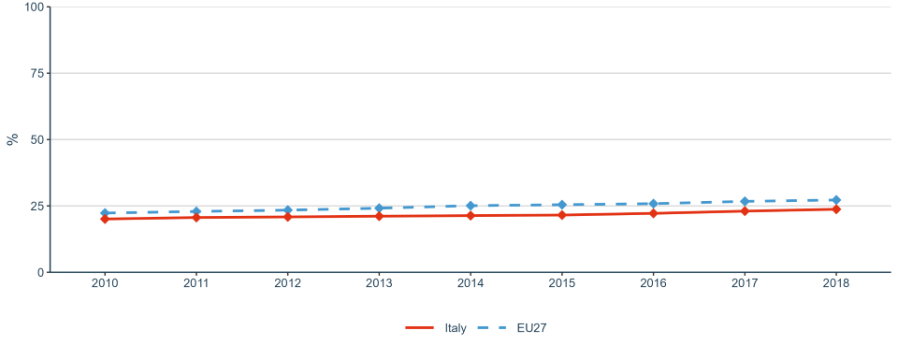

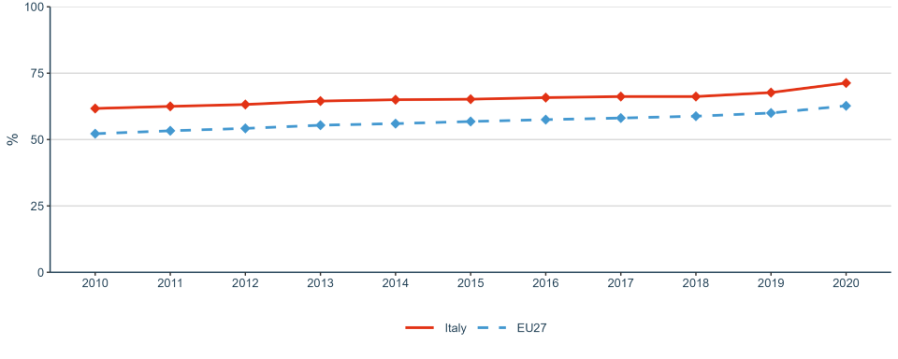
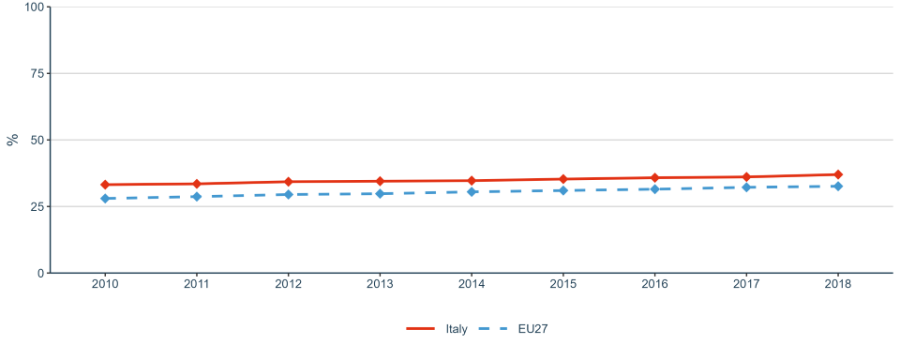
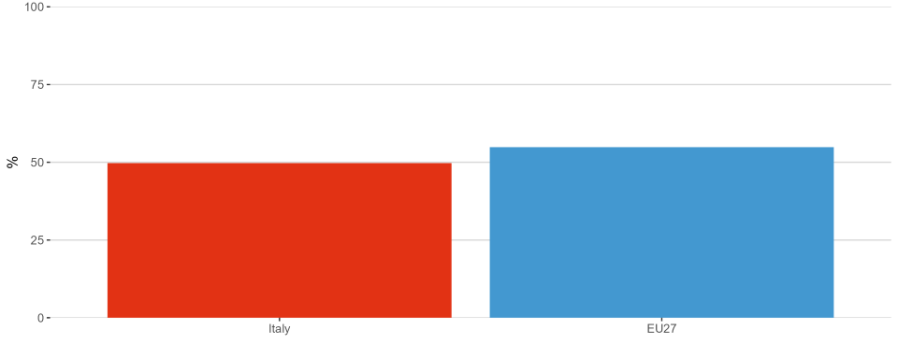
Sub-priority 1.4: Researchers’ careers and mobility and research assessment and reward systems



Sub-priority 1.5: Knowledge valorisation


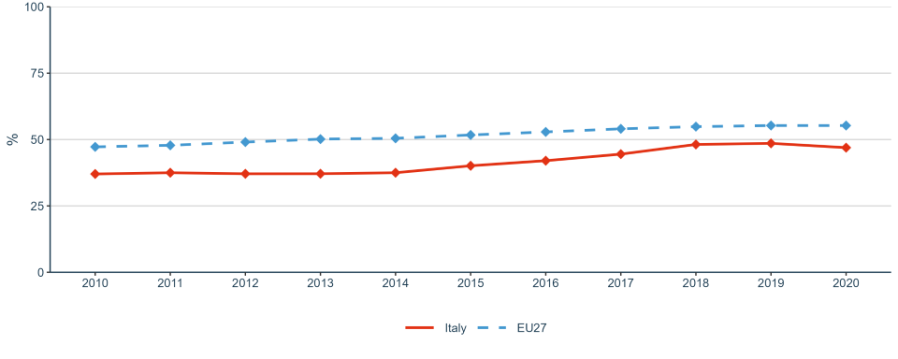
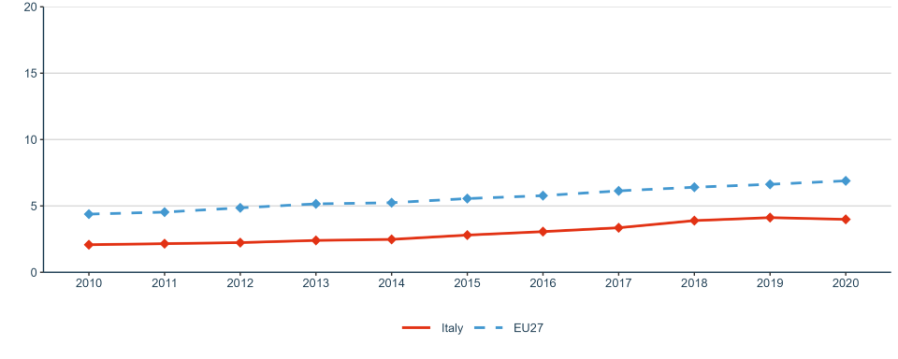

Sub-priority 1.6: Scientific leadership

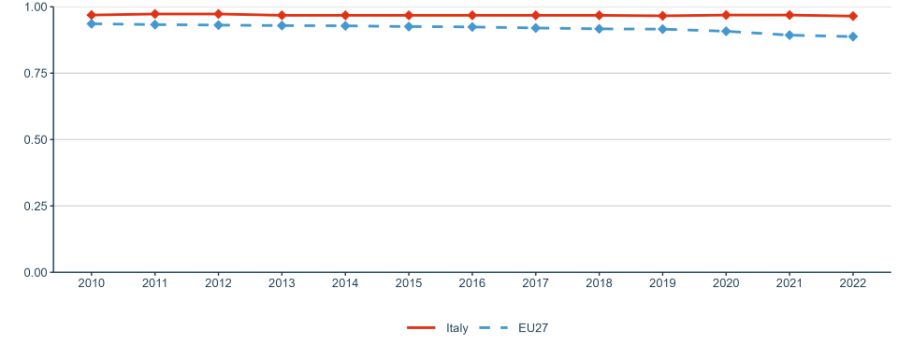
Sub-priority 1.7: Global engagement


Priority 2: Taking up together the challenges posed by the twin green and digital transition, and increasing society’s participation in the ERA
Sub-priority 2.1: Challenge-based ERA actions

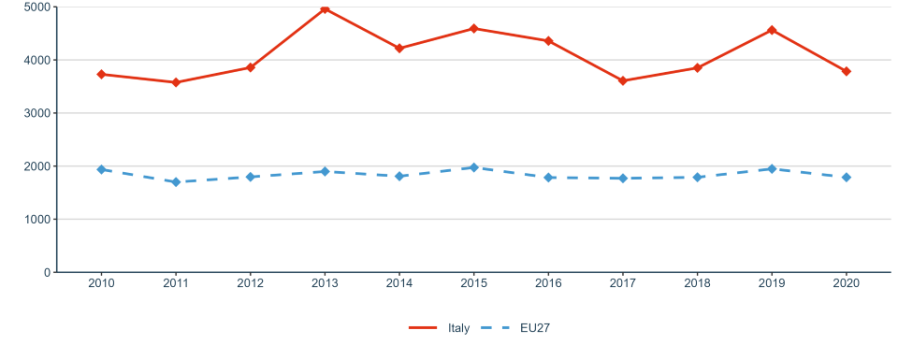
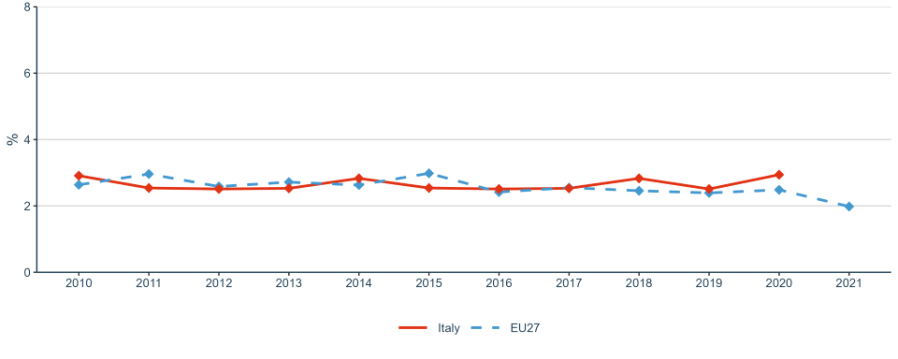
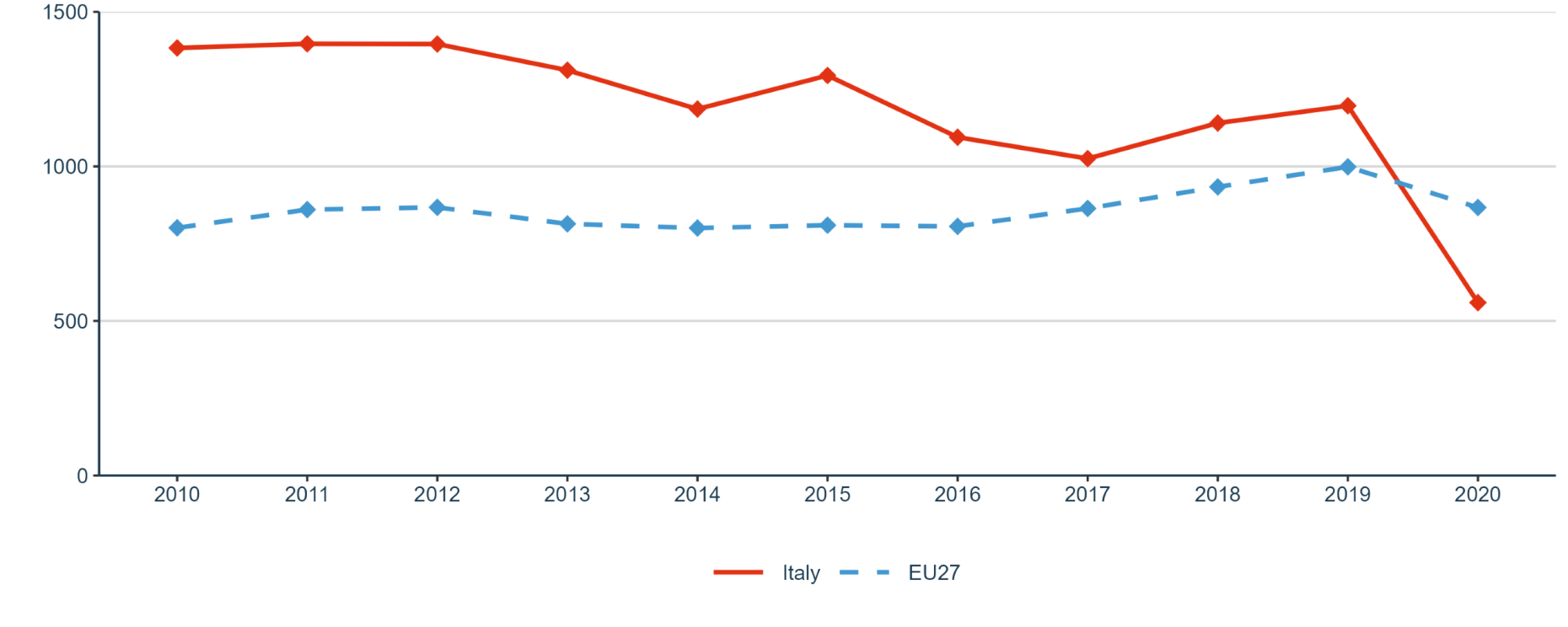
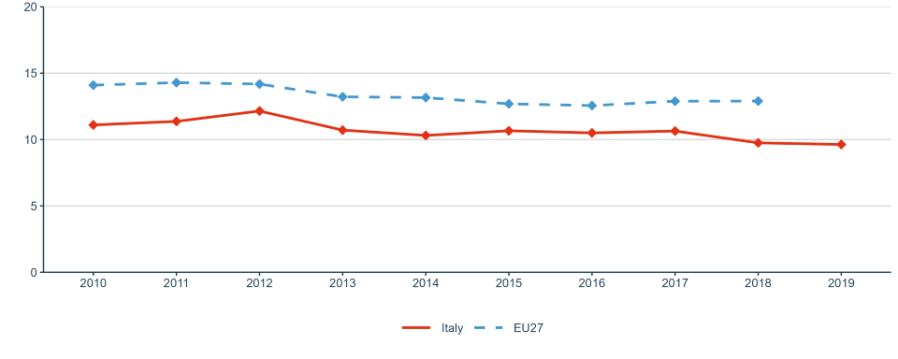
Sub-priority 2.2: Synergies with education and the European Skills Agenda

Sub-priority 2.3: Synergies with sectorial policies and industrial policy, in order to boost innovation ecosystems
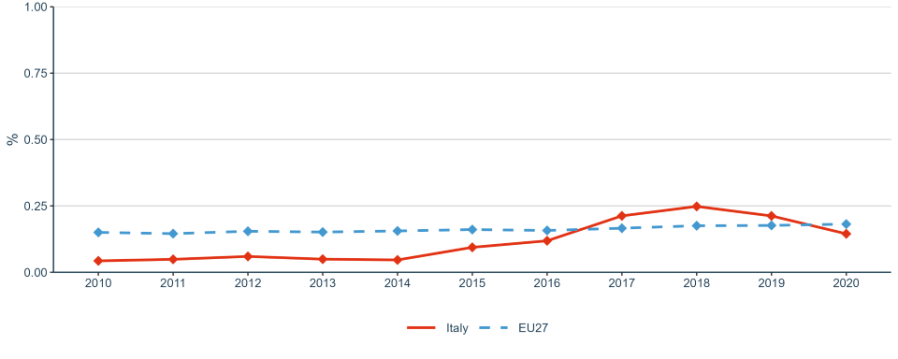
Sub-priority 2.4: An active citizen and societal engagement in R&I in all its dimensions
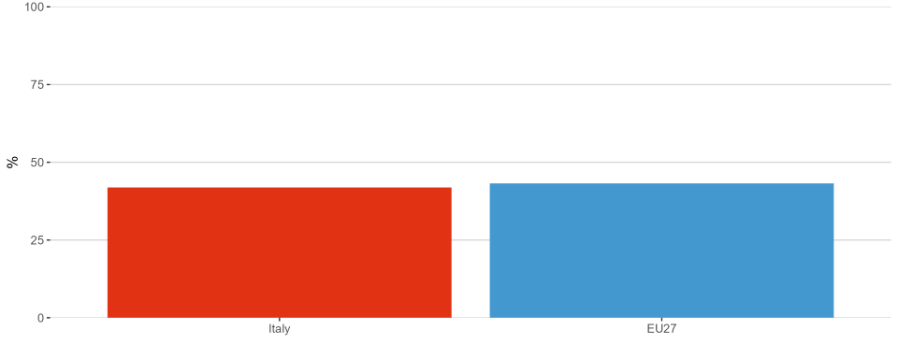

Priority 3: Amplifying access to research and innovation excellence across the Union
Sub-priority 3.1: More investments and reforms in countries and regions with lower R&I performance
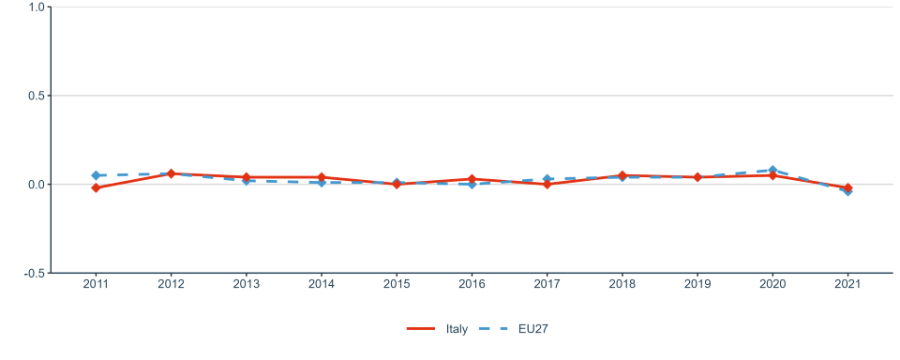
Priority 4: Advancing concerted research and innovation investments and reforms
Sub-priority 4.1: Coordination of R&I investments
